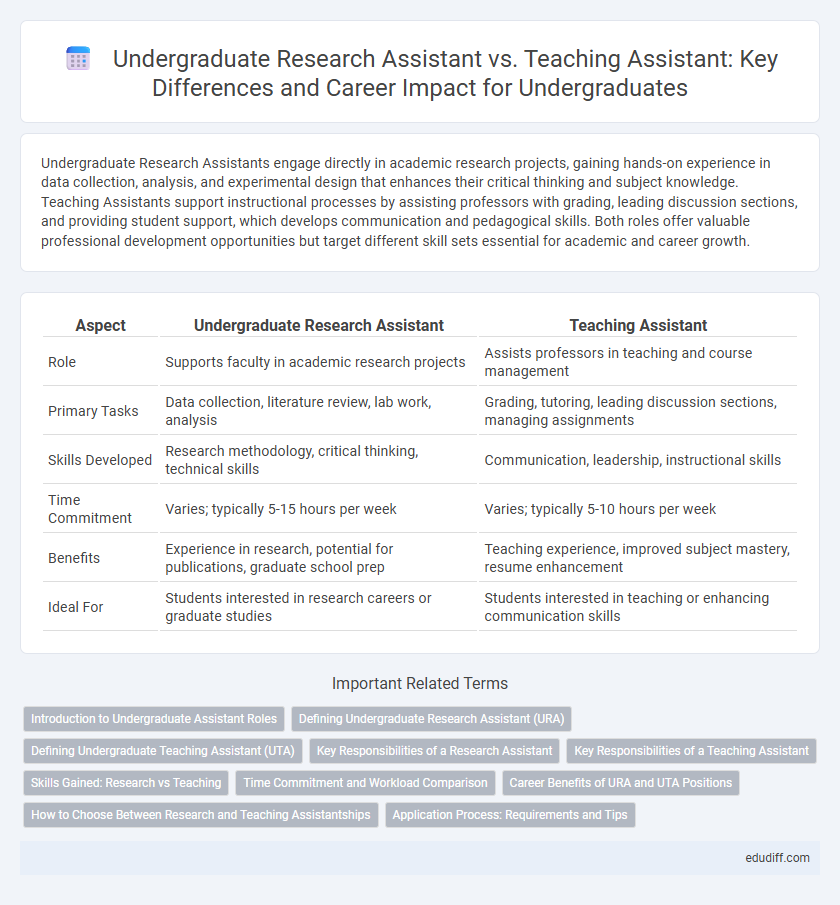Undergraduate Research Assistants engage directly in academic research projects, gaining hands-on experience in data collection, analysis, and experimental design that enhances their critical thinking and subject knowledge. Teaching Assistants support instructional processes by assisting professors with grading, leading discussion sections, and providing student support, which develops communication and pedagogical skills. Both roles offer valuable professional development opportunities but target different skill sets essential for academic and career growth.
Table of Comparison
| Aspect | Undergraduate Research Assistant | Teaching Assistant |
|---|---|---|
| Role | Supports faculty in academic research projects | Assists professors in teaching and course management |
| Primary Tasks | Data collection, literature review, lab work, analysis | Grading, tutoring, leading discussion sections, managing assignments |
| Skills Developed | Research methodology, critical thinking, technical skills | Communication, leadership, instructional skills |
| Time Commitment | Varies; typically 5-15 hours per week | Varies; typically 5-10 hours per week |
| Benefits | Experience in research, potential for publications, graduate school prep | Teaching experience, improved subject mastery, resume enhancement |
| Ideal For | Students interested in research careers or graduate studies | Students interested in teaching or enhancing communication skills |
Introduction to Undergraduate Assistant Roles
Undergraduate Research Assistants collaborate with faculty on academic projects, gaining hands-on experience in data collection, analysis, and scholarly writing. Teaching Assistants support instructors by leading discussion sections, grading assignments, and facilitating student understanding of course material. Both roles develop critical skills but differ in focus, with research assistants concentrating on investigation and teaching assistants emphasizing pedagogy.
Defining Undergraduate Research Assistant (URA)
An Undergraduate Research Assistant (URA) supports faculty-led research projects by collecting data, conducting literature reviews, and assisting with experimental procedures, providing hands-on experience in academic research. URAs develop critical skills in data analysis, scientific writing, and problem-solving, which are essential for graduate studies and research careers. Unlike Teaching Assistants who focus on instructional duties, URAs primarily contribute to advancing scholarly knowledge through research activities.
Defining Undergraduate Teaching Assistant (UTA)
An Undergraduate Teaching Assistant (UTA) supports faculty by facilitating discussions, grading assignments, and providing academic guidance to students in undergraduate courses. UTAs enhance learning experiences by clarifying course material and assisting with instructional duties under the supervision of professors. This role requires strong subject knowledge, communication skills, and a commitment to fostering student engagement.
Key Responsibilities of a Research Assistant
Undergraduate Research Assistants are primarily responsible for collecting and analyzing data, conducting literature reviews, and supporting experimental design under faculty supervision. They manage lab equipment, document research findings, and contribute to drafting reports or publications. These tasks are essential for advancing faculty-led research projects and developing practical skills in academic inquiry.
Key Responsibilities of a Teaching Assistant
Teaching Assistants support faculty by leading discussion sections, grading assignments, and managing classroom logistics to facilitate effective learning. They conduct review sessions, clarify course materials, and provide timely feedback to enhance student understanding. Teaching Assistants also assist in preparing instructional materials and maintaining academic records to ensure smooth course delivery.
Skills Gained: Research vs Teaching
Undergraduate Research Assistants develop critical analytical skills, data collection techniques, and proficiency in scientific methodologies, enhancing their ability to conduct independent investigations and contribute to academic publications. Teaching Assistants gain valuable communication, leadership, and organizational skills by facilitating classroom discussions, preparing instructional materials, and providing student support. Both roles strengthen problem-solving abilities, but research focuses on experimental design and data analysis while teaching emphasizes pedagogical strategies and student engagement.
Time Commitment and Workload Comparison
Undergraduate Research Assistants typically invest 10-15 hours per week conducting experiments, data analysis, and literature reviews, often with flexible hours aligned to project needs. Teaching Assistants generally commit 8-12 hours weekly, including preparing and leading discussion sections, grading, and holding office hours, adhering to fixed class schedules. The Research Assistant workload is project-driven and may fluctuate, while Teaching Assistant duties are more structured and consistent throughout the semester.
Career Benefits of URA and UTA Positions
Undergraduate Research Assistant (URA) positions provide valuable hands-on experience in data analysis, experimental design, and academic writing, enhancing critical thinking skills essential for graduate studies and research-focused careers. Teaching Assistant (UTA) roles develop communication, leadership, and organizational skills by facilitating discussions, grading, and tutoring, which benefit careers in education, management, and public speaking. Both URA and UTA experiences strengthen resumes, but URA roles are particularly advantageous for students pursuing STEM fields or academic research careers.
How to Choose Between Research and Teaching Assistantships
Choosing between an undergraduate research assistant and teaching assistant position depends on career goals and skill development priorities. Research assistantships provide hands-on experience in experimental design, data analysis, and academic publication, ideal for students pursuing graduate studies or research-intensive careers. Teaching assistantships enhance communication, leadership, and instructional skills, benefiting those interested in education, public speaking, or academic mentorship roles.
Application Process: Requirements and Tips
Undergraduate Research Assistant applications typically require a strong academic record, relevant coursework, and faculty recommendations, with candidates often needing to submit a statement of research interest and undergo an interview. Teaching Assistant positions demand excellent communication skills, a solid grasp of the subject, and prior tutoring or leadership experience, with applicants needing to provide transcripts and sometimes a demo teaching session. Tailoring applications to highlight specific skills and experiences aligned with either research methodologies or teaching effectiveness increases the likelihood of selection.
Undergraduate Research Assistant vs Teaching Assistant Infographic

 edudiff.com
edudiff.com